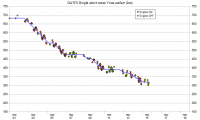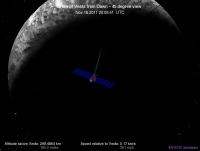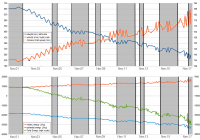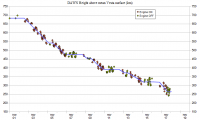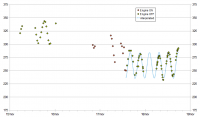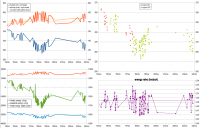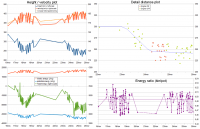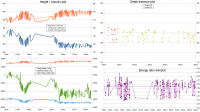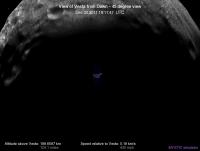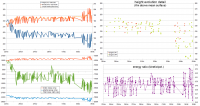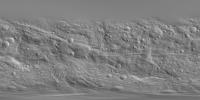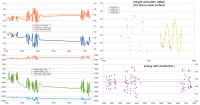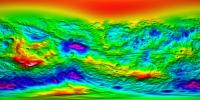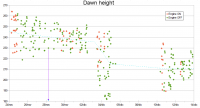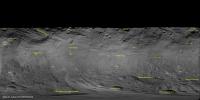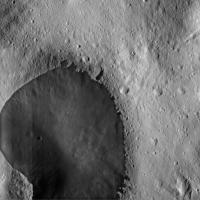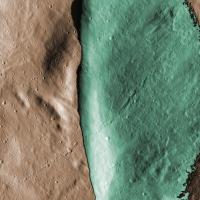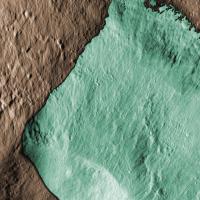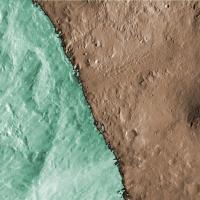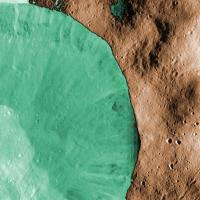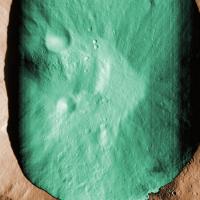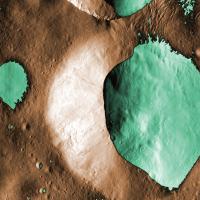Printable Version of Topic
Click here to view this topic in its original format
Unmanned Spaceflight.com _ Dawn _ LAMO
Posted by: dilo Nov 11 2011, 10:23 PM
I think is time to start this new topic, now that Dawn is more than half-way in the transition from HAMO to LAMO (as showed in the plot below).
Posted by: ElkGroveDan Nov 11 2011, 11:53 PM
Good thing we aren't calling it a "Low Mapping Altitude Orbit." ![]()
I get the feeling that many more surprises await us in finer detail as the surface resolution improves.
Posted by: dilo Nov 14 2011, 04:08 PM
Another way to show the progress from HAMO to LAMO is the following updated plot where points colors reflects engine status:
I tried to interpolate average height with a blue line. Time gaps are due in part to me (not continuous monitor) and in part to Mystic simulator black-outs.
EDIT: plot updated to Nov,15
Posted by: dilo Nov 16 2011, 08:49 PM
And finally, we are below 300km height... not far from final target! ![]()
Posted by: Phil Stooke Nov 16 2011, 08:59 PM
Hopefully the daily image releases will resume shortly!
Phil
Posted by: stevesliva Nov 16 2011, 09:54 PM
You mean images rather than other data products? Or images specifically from LAMO?
Pace hasn't slackened... now here:
http://dawn.jpl.nasa.gov/multimedia/imageoftheday/archives.asp?month=2011-November
Last two were HAMO images, though.
Posted by: Tunglere Nov 16 2011, 11:47 PM
Images from Nov. 10-13 don't currently show up on the Dawn Image of the Day page (http://dawn.jpl.nasa.gov/multimedia/imageoftheday/archives.asp?month=2011-November), but they do show up http://photojournal.jpl.nasa.gov/mission/Dawn.
Posted by: Phil Stooke Nov 17 2011, 04:15 PM
The latest four images were posted on the same day... I check every day, believe me. We had a minibreak. But these are spectacular!
Phil
Posted by: dilo Nov 17 2011, 10:20 PM
Updated situation, all plots:
Engines are now silent and average height is around 270 km...
Posted by: dilo Nov 18 2011, 05:20 PM
Now that we have an improved simulator (better Vesta digital model and, especially, more frequent screen updates) I am frequently monitoring the simulated height of the probe; in the last 24 hours, engines were off but orbit isn't completely stable:
The interpolated sinusoidal curve correspond to a 5.1 hours average period between 235 and 285 km height. The reason of slight phase/amplitude variations sould be the irregular gravity field of Vesta. In fact, as explained in the last http://dawn.jpl.nasa.gov/mission/status.asp, the purpose of these thrust stops is a natural or passive orbit adjustment (especially the orientation).
Edit: slightly modified previous text and updated plot (no orbit decay)
Posted by: dilo Nov 23 2011, 08:41 PM
New update after two long simulator black-outs:
Based on today's status report, "The spacecraft thrusts occasionally with its ion propulsion system, but most of the time it coasts, letting Vesta's gravity reorient its orbit."
Note also that last two published images were taken 15 days ago from an intermediate distance of 480km:
http://dawn.jpl.nasa.gov/multimedia/imageoftheday/image.asp?date=20111123 http://dawn.jpl.nasa.gov/multimedia/imageoftheday/image.asp?date=20111122
Posted by: Phil Stooke Nov 29 2011, 11:54 PM
"Dawn image EDR data will be publicly released to the science community by the PDS within 90 days after each acquisition phase. Therefore, raw Vesta approach images will be available in November 2011. Raw images for other acquisition phases including survey, high altitude (HAMO) and low altitude (LAMO) mapping orbits will be delivered throughout 2012"
"However, radiometrically calibrated PDS images (RDRs) will be publicly released six months after Vesta departure"
... from Jeffery Anderson's AGU poster abstract.
Exciting!
Phil
Posted by: elakdawalla Nov 30 2011, 02:34 AM
![]()
![]()
![]() Time for us to lurk on the Small Bodies Node website.....that is where they'll likely be hosted, right?
Time for us to lurk on the Small Bodies Node website.....that is where they'll likely be hosted, right?
Posted by: Phil Stooke Nov 30 2011, 04:18 AM
This link...
http://pds-smallbodies.astro.umd.edu/data_sb/resources/release_sched.shtml
... suggests a later date.
Phil
Posted by: dilo Dec 1 2011, 07:02 AM
...and suggests also a new Vesta departure date (shifted from July 2012 to Jan 2013), probably in order to study also North Pole region!
Posted by: SFJCody Dec 1 2011, 07:06 AM
I believe that's the PDS data release date, not the spacecraft event date.
Posted by: angel1801 Dec 1 2011, 12:03 PM
I did a Solar System Simulator run for Vesta and I worked out that equinox for Vesta will be on or about July 27, 2012.
You can work this out by choosing the "from above" viewpoint for Vesta and finding the date when the phase angle is 90 degrees. This is when the sun's terminator is exactly over the North Pole.
I got this idea from doing this for Mercury where the phase angle as viewed directly from either pole is always 90 degrees.
Posted by: Greg Hullender Dec 1 2011, 03:21 PM
I think shifting the Vesta departure date would require a change to the laws of celestial mechanics--I don't think there's funding for that. :-)
--Greg
Posted by: algorimancer Dec 1 2011, 03:49 PM
I think that with the ion drive, the laws of celestial mechanics allow a bit more leeway than otherwise. That said, I'd rather move on to Ceres sooner rather than later -- that's a much larger and more interesting world. Of course, I'd also like to see real-time data releases :/
Posted by: Explorer1 Dec 1 2011, 09:01 PM
Yeah, Dawn's launch was delayed three months, but the ion drive gives so much leeway it didn't matter in the end (compared with a conventional launch to Mars for example, that has a very specific window).
Posted by: stevesliva Dec 1 2011, 09:52 PM
http://dawn.jpl.nasa.gov/multimedia/vesta_dawn_gallery.asp
Has this new 3D video goodness:
http://dawn.jpl.nasa.gov/feature_stories/dawn_soars_over_vesta.asp
Posted by: stevesliva Dec 2 2011, 12:47 AM
http://www.planetary.org/blog/article/00003283/
Amazing.
Posted by: Greg Hullender Dec 2 2011, 06:06 PM
Supposedly that delay was running up against the window from Vesta to Ceres, so I suspect there may not be much more leeway to stay at Vesta. Perhaps someone who knows for sure will chime in.
--Greg
Posted by: PDP8E Dec 2 2011, 06:50 PM
The Dawn Journal and Dr. Marc Rayman should get some sort of award for 'modern science literature'. It is always a fascinating read.
Posted by: dilo Dec 3 2011, 06:10 AM
I agree, PDP8E.
Posted by: dilo Dec 3 2011, 07:22 PM
After last burns, nominal LAMO height (200km above average radius) was just reached:
However, now orbit needs to become circular...
Posted by: dilo Dec 4 2011, 09:40 PM
No burns in last hours, orbits is now around 185x245km:
Curiously, most of last burns occurred around apoastron and this reduced periastrum distance only, increasing eccentricity...
Posted by: machi Dec 6 2011, 05:53 PM
Interesting news via Emily's twitter:
"Russell: pole position for Vesta measured by Dawn differs from astronomically determined value. #AGU11 (1 hour ago)"
"Russrll: spring will return to dark north pole later than thought, so they will need to delay Vesta departure in order to image it. #AGU11 (1 hour ago)"
Posted by: stevesliva Dec 8 2011, 06:08 AM
Several updates here:
http://dawn.jpl.nasa.gov/multimedia/vesta_dawn_gallery.asp
Dated Dec. 5th, but I think they showed up more recently.
Posted by: claurel Dec 9 2011, 07:38 PM
Now that Robert Gaskell's shape model of Vesta is available, I used it to create a movie comparing Vesta to two other Solar System bodies: Phoebe and Mimas. The movie contrasts the sizes, shapes and rotation states of the three objects. Though I'm familiar with the numbers, it's still impressive to see just how quickly Vesta spins (though I suppose contrasting it with a synchronously rotating moon isn't the fairest comparison.)
http://www.youtube.com/watch?v=dSGh_JHNFSI&feature=youtu.be
Enjoy!
--Chris
Posted by: ElkGroveDan Dec 9 2011, 07:51 PM
Beautiful. Thanks for sharing.
Posted by: Sarunia Dec 10 2011, 11:04 PM
With the shape from Dr. Robert Gaskell (and providing by NAIF), I make http://www.youtube.com/watch?v=JCrXZCA7MbE, projecting some pictures from Survey Orbit to the shape.
And there's the bumpMap (simple cylindrical projection). It can be used with Celestia.
Posted by: Phil Stooke Dec 11 2011, 02:55 AM
Nice! This can be turned into a shaded relief map simply by using the 'emboss' filter in Photoshop, or its equivalent. Here's one version - varying the illumination direction makes drastic changes to the appearance of the map. The two distinct sets of troughs show up very well here.
Phil
Posted by: Bill Harris Dec 11 2011, 07:23 AM
And Nice! ^2, Phil. You can see a lot of history there.
--Bill
Posted by: dilo Dec 11 2011, 08:34 AM
Beautiful simulated views in this video, Sarunia! About the bumpMap, do you know which basic shape should I use with software other than Celestia?
(if is an ellipsoid, I would like to know axes lenghts...)
Posted by: scalbers Dec 11 2011, 04:47 PM
Videos of numerous AGU talks on Vesta from this past week are available online here (three separate sessions). I saw just a few of them in person - mainly about the large south polar crater.
http://sites.agu.org/fallmeeting/scientific-program/sessions-on-demand-6-december/
Posted by: dilo Dec 11 2011, 05:45 PM
After long hiatus (related to safe mode event one week ago) the simulator is up again! Yesterday, several short engine burns put Dawn on a 209 km average height but, interestingly, now eccentricity is increasing due to Vesta gravitational field:
The yellow curve is my rough attempt to interpolate trend through a sinusoid with 4.3 hours period and increasing amplitude (8 km/day) - anyway, remember that simulator is based on a nominal orbit design, not real time data!
[I would like to thank Dr Rayman for additional info through private communications!]
Posted by: Sarunia Dec 11 2011, 07:20 PM
Thanks, dilo.
For the bump projection, a tri-axial ellipsoid 289x280x229 km (recommended values by NAIF) is used. So a spheroid (289x229) works fine.
EDIT: correct wrong value: 229 instead of 219.
Posted by: djellison Dec 11 2011, 09:10 PM
Did my own conversion from the greyscale map into something a bit more funky ![]()
Posted by: stewjack Dec 11 2011, 09:18 PM
As an interested amateur, the following AGU video appears to be a good summary of what has been discovered about Vesta so far. It is 2 hours long and I have only viewed 40% of it, but the quality has been very good up till now, and I understood most of it. It is HD and if you download it be prepared for a 900 MB file.
Here is the link: http://vimeo.com/33317236
http://vimeo.com/33317236
Note:This is not a link to the AGU page with the embedded player. It is a direct link to the hosting site VIMEO. Registered members can download file from here.
AGU page: Sessions on Demand (No downloads)
http://sites.agu.org/fallmeeting/scientific-program/sessions-on-demand-8-december/
Jack
Posted by: claurel Dec 13 2011, 11:32 PM
For Celestia users, here's an add-on that replaces Celestia's default low-resolution Vesta model with the Gaskell model:
http://www.shatters.net/~claurel/celestia/models/vesta.zip
The model contains less than 50,000 triangles, so it should display well on any system. It uses a normal map to supply the extra detail from the original high-resolution shape model.
--Chris
Posted by: Sarunia Dec 13 2011, 11:58 PM
Thank you, I was just preparing a conversion for celestia but now i know that it's not necessary and it save my time ![]()
Posted by: stevesliva Dec 14 2011, 01:43 AM
First (?) image from near LAMO?
http://dawn.jpl.nasa.gov/multimedia/dawn_orbiting_over_vesta.asp
Taken from 230km.
Posted by: dilo Dec 14 2011, 06:17 AM
Almost. Picture was taken before the two last main burns which reduced average height from 240 to 211 km, last week:
the purple arrow indicate the exact time/height when (I guess) the picture was snapped...
Posted by: stevesliva Dec 15 2011, 07:31 PM
And now the image of the day is stalled again. Let's see some boulders!
Posted by: dilo Dec 15 2011, 07:56 PM
Steve, based on last http://dawn.jpl.nasa.gov/mission/status.asp, The Dawn "image of the day" will take a break until Jan. 9.
We have to wait next year!
Posted by: stevesliva Dec 15 2011, 08:04 PM
Doh. Thanks for pointing that out, it'll save some clicks on my part. That one photo is such a tease.
Posted by: Jaheira Dec 20 2011, 12:55 AM
Is it just me, or does that sharp, young crater in the top right of the image below have gullies in its walls that look remarkably similar to those in craters on Mars? The debate has been raging for some years now whether Martian crater gullies are formed by dry flow or by the flow of brine. I'm not suggesting for one moment that there's liquid flowing on the surface of Vesta, but the similarity of gullies here might suggest that most, if not all, Martian gullies formed via a dry mechanism.
http://dawn.jpl.nasa.gov/multimedia/images/FC21A0014298_full.jpg
Posted by: Marz Dec 20 2011, 06:54 PM
I noticed that same feature and assumed it was a landslide triggered by the same mechanism that created the apparent fault above the rim. As to what caused the fault, I'm not sure.
I believe the "dry flow" mechanism for small scale flows of sediment on craters of Mars requires dry ice as the volatile that sublimates and then causes unweathered sediment to be exposed, making a dark band. I don't think the landslide on Vesta pictured here would be applicable to those discussions.
Posted by: stevesliva Dec 21 2011, 06:05 PM
Five LAMO images have appeared here:
http://dawn.jpl.nasa.gov/multimedia/vesta_dawn_gallery.asp
Posted by: volcanopele Dec 28 2011, 04:25 AM
14 more names have been approved for use on Vesta, including the other two craters in the "snowman"
http://astrogeology.usgs.gov/HotTopics/index.php?/archives/436-Fourteen-More-Names-Approved-for-Surface-Features-on-Vesta.html
I've updated my labeled Vesta map to include these new names
Posted by: Greg Hullender Jan 1 2012, 09:51 PM
--Greg
Sure enough, I got the following from Marc Rayman, which he invited me to share here:
As soon as we determined the Vesta pole during the approach phase, we knew what it meant for seeing the north pole, but our plan to depart in July 2012 has not changed. Our agreement with NASA HQ (formalized in our level 1 requirements) has always been that we would image at least 80% of the surface of Vesta at 100 m/px in our panchromatic channel and at least three color filters. We have already done better than that, so it is not obvious that we have to see farther north, much as one might consider it to be neat to do so.
In case this appears to be inconsistent with Emily's tweet about what Chris Russell said here at the AGU, let me be be explicit about it. It is correct that we would need to delay departure in order to see all the way to the north pole. That is not the same as saying we will delay departure.
While plans may change, we remain scheduled for departure in July. We already have fabulous data on Vesta, and we certainly will have even more by then. It certainly would be nice to see the entire surface, but even if we don't, there's no doubt that what we will have seen at Vesta will be exceptionally valuable.
Hope everyone has a happy (and interesting) New Year!
--Greg
Posted by: Holder of the Two Leashes Jan 2 2012, 08:20 AM
Thanks Greg.
I'd be interested to know how far north the project scientists think that the antipode(s) of the one or two giant southern impacts are, and the chances of them being observed before the end. Or perhaps they've already been spotted?
Posted by: algorimancer Jan 3 2012, 01:42 PM
Spacedaily has an article up today (http://www.spacedaily.com/reports/Space_Mountain_Produces_Terrestrial_Meteorites_999.html) that states with regard to Dawn's Vesta mission that "no one expected a 13-mile high mountain, two and a half times higher than Mount Everest". Considering the earlier Hubble results, they probably should have fact-checked that line -- or were they mislead by a press release?
Posted by: Greg Hullender Jan 5 2012, 03:42 PM
New Dawn Journal: http://dawn.jpl.nasa.gov/mission/journal_12_30_11.asp
Nice info about the challenges of maintaining such a low orbit around such an irregular body. Also nice to learn that they haven't had to use even one day of their 40-day reserve. (The buffer in the science schedule to allow for things to go wrong.) If I'm interpreting that right, they essentially get a 40-day extended mission at Vesta for free, which is kind of cool.
By the way, this is my 1,000th post at UMSF, which is also kind of cool.
--Greg
Posted by: stevesliva Jan 5 2012, 09:02 PM
What a tease to link to the image of the day after discussing the wonderful LAMO images... because none of them are there yet.
Posted by: Phil Stooke Jan 5 2012, 09:51 PM
No... they are here instead:
http://dawn.jpl.nasa.gov/feature_stories/vesta_low_altitude_images.asp
Phil
Posted by: stevesliva Jan 5 2012, 10:01 PM
I know there are some kicking around. Just hoping for the image of the day to start up again.
Posted by: pablogm1024 Jan 6 2012, 02:49 PM
They are expected to restart on Monday, January 9th.
pablogm
Posted by: pablogm1024 Jan 9 2012, 02:54 PM
Indeed, IOTD has restarted http://dawn.jpl.nasa.gov/multimedia/imageoftheday/image.asp?date=20120109, even if the gallery page does not seem to be updating properly.
Enjoy,
pablogm
Posted by: stevesliva Jan 16 2012, 08:08 PM
http://dawn.jpl.nasa.gov/multimedia/imageoftheday/image.asp?date=20120116
Interestingly shaped pit or crater lower left.
Posted by: Marz Jan 24 2012, 09:39 PM
Today's image is a nice 3-D anaglyph of impact craters from a binary asteroid impact:
http://dawn.jpl.nasa.gov/multimedia/imageoftheday/image.asp?date=20120124
Posted by: stevesliva Jan 26 2012, 06:28 PM
Three releases on the multimedia page that would seem to indicate there will be a release / NASA news item about long-lived ice on Vesta.
http://dawn.jpl.nasa.gov/multimedia/vesta_global_map.asp
http://dawn.jpl.nasa.gov/multimedia/vesta_temperatures.asp
http://dawn.jpl.nasa.gov/multimedia/vesta_south_pole.asp
Ah, yes, this release:
http://www.jpl.nasa.gov/news/news.cfm?release=2012-024
Also, today's image:
http://dawn.jpl.nasa.gov/multimedia/imageoftheday/image.asp?date=20120126
... Finally, boulders, as requested. ![]()
Posted by: Phil Stooke Feb 5 2012, 03:49 AM
Some pretty clear flows on Vesta in the latest image:
http://dawn.jpl.nasa.gov/multimedia/images/imageoftheday/201202/IOTD-148-full.jpg
Probably the clearest I've seen so far.
Phil
Posted by: Marz Feb 14 2012, 10:14 PM
http://dawn.jpl.nasa.gov/multimedia/vesta_global_map.asp
http://dawn.jpl.nasa.gov/multimedia/vesta_temperatures.asp
http://dawn.jpl.nasa.gov/multimedia/vesta_south_pole.asp
Ah, yes, this release:
http://www.jpl.nasa.gov/news/news.cfm?release=2012-024
Also, today's image:
http://dawn.jpl.nasa.gov/multimedia/imageoftheday/image.asp?date=20120126
... Finally, boulders, as requested.
Comparing Vesta's axial tilt of 27 to Ceres with 3, would Ceres be much more likely to retain ice at the poles. Could vapor sublimating from the equatorial regions on Ceres be deposited as layers of frost at the poles, perhaps forming ice caps, or is the surface gravity far too low for this to occur?
Posted by: ngunn Feb 14 2012, 11:07 PM
Good question. I hope you get an answer from someone better informed than I am but I'll have a go. I think there's plenty of ice there. There certainly is on Mars although it's a warmer place. Surfaces exposed to the vacuum of space get dessicated but you don't have to dig far below the surface to find the stuff as Phoenix proved on Mars. Will we see it on the surface of Ceres? I don't know. It may have sublimed off all lit surfaces. You might need an impactor (or a hand torch for a walk in the dark).
Why do I always get attracted to OT discussions ![]() ?
?
Ceres: somebody start a topic - we're almost on the way.
Posted by: Greg Hullender Feb 16 2012, 02:12 AM
I see that we've got four more months at Vesta, but we're three years away from Ceres.
http://dawn.jpl.nasa.gov/mission/timeline.asp
I suppose I knew that the main mission plan ends abruptly at Ceres, but I was surprised to see that it calls for only five months of observations. That barely seems like enough time to get into LAMO. I hope the Vesta results are compelling enough to get an extended mission approved because it seems like they'll need it before they actually have much in the way of solid results from Ceres.
--Greg
Posted by: Phil Stooke Feb 16 2012, 02:58 AM
The short time at Ceres in the primary mission is the main reason that any extended mission will stay at Ceres rather than going on somewhere else. They will need lots of extra time for global high resolution mapping.
Phil
Posted by: scalbers Feb 26 2012, 06:00 PM
Here's the released map with feature names put on top warped according to the map projection. Of course the credit info in the lower left wouldn't fit this warping scheme...
Steve
Posted by: stevesliva Feb 29 2012, 12:08 AM
Two interesting image releases on Aricia Tholus last week:
http://dawn.jpl.nasa.gov/multimedia/imageoftheday/image.asp?date=20120222
http://dawn.jpl.nasa.gov/multimedia/imageoftheday/image.asp?date=20120221
Posted by: john_s Feb 29 2012, 03:42 AM
My impression, especially from those new images, is that calling it a "tholus" was premature- it looks like just a random hill that happens to have a dark-rayed impact crater superposed on it. Of course there still must be *something* special about it to produce those dark rays...
John
Posted by: Gsnorgathon Feb 29 2012, 11:20 PM
But doesn't "tholus" just mean hill, with regard to how it formed? The topo image sure makes it look like a hill.
Posted by: john_s Mar 1 2012, 12:37 AM
That might be technically true, but "tholus" on other bodies has typically been used to denote what appears to be a volcanic construct (e.g. Inachus Tholus on Io, Hecates Tholus on Mars). Are there any counter-examples, of other non-volcanic "tholi"?
John
Posted by: Gsnorgathon Mar 1 2012, 02:23 AM
Umm... how about http://photojournal.jpl.nasa.gov/catalog/PIA15192? OK, yeah. That's what I thought. But according to the planetary names folks, they are playing by the rules: http://planetarynames.wr.usgs.gov/DescriptorTerms. Maybe they need a new feature name. What's Latin for "bump"?
Posted by: pablogm1024 Mar 2 2012, 10:10 AM
Early on in the Vesta orbital phase, the Framing Camera operations team, far more concerned about correct orientation of the images and meaningful navigation than about scientific or toponymic soundness, concocted a series of informal names that mainly served the purpose of designating easily identifiable features. One of these nicknames was "The Snowman", which has now become part of the popular culture about Vesta. Another one was "Dark Volcano".
Cheers.
Posted by: Phil Stooke Mar 2 2012, 02:25 PM
"tholus" on other bodies has typically been used to denote what appears to be a volcanic construct
True! But these names are supposed to be purely descriptive, not carrying any genetic implications. I agree the term is mainly used for smaller volcanic hills, but it doesn't have to be. Possible counter-example: Scandia Tholi, Mars, a rag-tag collection of hills that don't look like volcanic shields or cones to me.
Also - new names added on Tuesday:
http://planetarynames.wr.usgs.gov/images/vesta.pdf
Phil
Posted by: Astro0 Apr 19 2012, 05:05 AM
40 extra days at Vesta! ![]()
http://www.jpl.nasa.gov/news/news.cfm?release=2012-107
Posted by: Phil Stooke Apr 19 2012, 12:03 PM
Yes, and they have now released over 200 pictures of the day.
Phil
Posted by: charborob Apr 19 2012, 12:14 PM
In LAMO, Dawn seems to be taking only nadir-pointing images. At least, those that were published are of this type, unless I missed something. Do they sometimes slew the spacecraft in order to take oblique images?
Posted by: Phil Stooke Apr 19 2012, 05:03 PM
LAMO is all about the composition-mapping instrument, with imaging just riding along. They have to look down pretty much all the time, I think.
Phil
Posted by: pablogm1024 Apr 21 2012, 03:16 PM
I can confirm Phil's comment. As Marc Rayman has mentioned several times on his blog, the Gamma Ray and Neutron Detector (GRaND) is the prime instrument in this phase. This instrument will provide the elemental composition of the surface (up to 1 meter depth) thanks to the nuclear emissions induced by the background cosmic radiation. The problem is that these emissions are very weak, and even with a detector as finely tuned as GRaND it requires an extremely large amount of integration time to get above the noise.
The off-nadir imaging, which is critical for the stereographic reconstruction of the surface, will continue in the second HAMO phase later this year.
Regards,
pablogm
Posted by: Juramike Apr 25 2012, 06:59 PM
A really nice "uber"-image release today, with lots of neat related image and caption releases:
http://dawn.jpl.nasa.gov/feature_stories/asteroid_vesta_secrets_revealed.asp
A gorgeous shot of Aquilia: hhttp://dawn.jpl.nasa.gov/multimedia/aquilia_area_color.asp
Vibidia Crater: http://dawn.jpl.nasa.gov/multimedia/vibidia_crater_color.asp
(obviously the result from a Pocket Tanks Chaos Grenade)
Posted by: Hungry4info May 7 2012, 07:58 PM
http://www.nasa.gov/home/hqnews/2012/may/HQ_M12-082_Dawn_Update.html
Posted by: Mariner9 May 8 2012, 05:11 PM
I suspect that the news conference is timed to coincide with DAWN results being printed in this week's upcoming issue of Science. I went to the lecture at Caltech last week and Carol Raymond mentioned the publication, and artfully dodged at least one question from the audience that apparently would have prematurely revealed something that will be included in the articles.
I have been collecting the "special issues" of Science on the planetary missions for the last 20 years. The articles are a bit of a tough read compared to something more mainstream like Scientific American, but it just makes me feel a bit closer to the real discovery process.
For anyone not aware of it, you can locate back issues at http://www.sciencemag.org/content/by/year.
And, after a lot of searching, you can find how to order issues at: http://www.sciencemag.org/site/help/readers/order.xhtml
For some reason I have had mixed sucess with the online forms, sometimes I get acess and can do it online, and sometimes end up with a hard copy PDF file instead. When that happens I just call the toll free number and do it the old fashion "talk to someone" way.
Posted by: Holder of the Two Leashes May 10 2012, 04:42 PM
News conference set to start in one hour twenty minutes from this posting.
http://www.nasa.gov/ntv
Posted by: Floyd May 10 2012, 05:58 PM
About to start, 98+ viewers
Posted by: Explorer1 May 10 2012, 06:00 PM
Starting now...
Posted by: Paolo May 10 2012, 06:05 PM
meanwhile, papers have appeared in Science http://www.sciencemag.org/content/336/6082.toc (behind the paywall)
Posted by: ElkGroveDan May 10 2012, 06:31 PM
Can we go now? I want to see Ceres.
Posted by: Holder of the Two Leashes May 10 2012, 06:44 PM
So, I guess I'll go ahead and hang on to my little diogenite samples. A bit more confidence in their source.
Posted by: DrShank May 10 2012, 06:51 PM
No need to worry! staying longer at Vesta wont change our arrival time at Ceres.
p
Posted by: dilo May 10 2012, 06:56 PM
Interesting conference, though I see less than a dozen people in the room (some of them appear annoyed too!)...
Posted by: DrShank May 10 2012, 07:26 PM
a lot of reporters like to do this sort of thing remotely now. or simply call beofre or after. kinda weird talking to a half empty room sometimes . . .
Posted by: Paolo May 11 2012, 07:05 AM
a quick remark on the conference: I noticed that the speakers pronounced Ceres as something like "series". the correct pronunciation should be something like "Che-reh-ss". it's Latin, it's not American-English!
Posted by: centsworth_II May 11 2012, 12:44 PM
It is interesting to know the correct Latin pronunciation but I don't think that makes the American-English pronunciation incorrect.
Posted by: charborob May 11 2012, 01:35 PM
FWIW, in French, we write "Cérès" and pronounce it "say-ress" (short "say" and stress on "ress").
Edit: In classical Latin, the letter "C" was pronounced "K", but I don't think anybody would want to pronounce "kay-ress".
Posted by: elakdawalla May 11 2012, 03:40 PM
I've noticed that conferences held at HQ are particularly poorly attended physically, though there are clearly quite a lot of people on the phone. I prefer following briefings on the phone because that way I can study the released images as I listen to the scientists talk about them. I think it's kind of a waste of both money and of busy people's time to fly all those people to HQ for briefings when they could conduct them perfectly well remotely.
Though this time I wasn't on the phone at all, as I was playing in the desert with rovers instead
Posted by: Phil Stooke Jul 24 2012, 01:25 AM
Dawn isn't in LAMO now, it's moved back upstairs, but there are still lots of great pics from lower down on the website. Today's image shows a crater with a shadow and detail in the shadow brought out by special processing. Here I have combined the two versions of their image.
Phil
Posted by: DrShank Jul 25 2012, 02:17 AM
Phil is right,
we are now in HAMO2, looking at the north pole for the first time. we have also been looking at the shadowed areas since last! I hadnt realized we had not shown any of these yet! quite amusing that we can see into the shadows in this way. nice camera. i hope to show some more someday soon.
paul
Posted by: dilo Jul 26 2012, 05:57 AM
Well, to be precise we aren't in HAMO2 anymore because, starting from yesterday, Dawn ignited engines and started the depart phase from Vesta...!
Posted by: Phil Stooke Jul 26 2012, 03:41 PM
I'm looking forward to seeing some whole-frame images during the departure, a different view than we had during the approach.
Phil
Posted by: dilo Jul 26 2012, 08:32 PM
Based on simulated viewer and http://dawn.jpl.nasa.gov/mission/journal_07_25_12.asp, engines were ON for more than 24 hours and, as showed in the following plots, Dawn orbit is rapidly changing:
Last apoapsis was 776.5 km above Vesta surface, about 63 km above HAMO2 in last days... Total energy is clearly increasing too, however departure phase will last more than a month.
Meanwhile, starting from Phil idea, I made these compositions of last 3 posted images in the "revealing shadows" series:
(first one is in Oppia quadrangle and latter two inside Marcia quadrangle). Consider that, for shadowed region, besides the different hue I used negative image in order to have an illumination roughly coherent with illuminated part.
Posted by: dilo Jul 29 2012, 03:46 PM
Further update on escape maneuver:
Dawn is rapidly receding from HAMO orbit thanks to uninterrupted engine thrust; based on simulator figures, during last orbit there was an increase of apoapsis/periapsis heights of 57.9/59.3 km (a rising rate greather than 80 km/day); total energy/mass increased by 2.1 kJ/Kg in 4 days.
Added: same processing for the 5th image of "revealing shadows" series, in the Floronia quadrangle:
Posted by: dilo Aug 1 2012, 11:05 PM
Further update:
The first engine stop, on July 31, lasted less than 15 hours and, after this, energy increase was very regular.
Posted by: dilo Aug 5 2012, 06:08 AM
The second engine stop, on Aug 2-4, was longer (between 30 and 45 hours) and, probably, was used to map the northern emisphere; in fact Dawn flied twice above North Pole at an estimated height of 1450 km (considering Vesta shape).
Herebelow last two "revealing shadow" processed images, from Caparronia and Floronia quadrangles, respectively:
Posted by: machi Aug 11 2012, 03:03 PM
Very interesting color image of the "Snowman" region on the asteroid Vesta:
http://photojournal.jpl.nasa.gov/catalog/PIA15674
Posted by: Phil Stooke Aug 14 2012, 12:03 AM
http://pds-smallbodies.astro.umd.edu/data_sb/resources/release_sched.shtml
According to this data release schedule, we should get raw approach and HAMO data soon at PDS. But the arguments over coordinate systems may delay this a bit.
Phil
Posted by: lyford Aug 15 2012, 01:08 AM
More reaction wheel problems: ![]()
http://www.nasa.gov/mission_pages/dawn/news/dawn20120813.html
Posted by: TheAnt Aug 24 2012, 12:09 PM
Yes I got that from http://www.astronomynow.com/news/n1208/15dawn/.
Now that they are optimistic about getting over to Ceres without reaction wheels, I cant shrug off the thought that the pointing for instruments and camera will be affected.
Anyhow since that Dawn is in the departure phase, perhaps it is time to start a 'Cruising to Ceres' thread. =)
Posted by: stevesliva Aug 24 2012, 08:32 PM
Are there only two wheels?
Posted by: djellison Aug 24 2012, 10:09 PM
Two fully functioning left of the 4 functioning at launch.
Posted by: stevesliva Jan 5 2013, 07:32 AM
There are some new captioned releases here:
http://dawn.jpl.nasa.gov/multimedia/vesta_dawn_gallery.asp
... and I can't seem to see that they relate to any new paper or conference release.
Powered by Invision Power Board (http://www.invisionboard.com)
© Invision Power Services (http://www.invisionpower.com)

